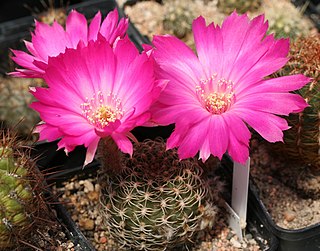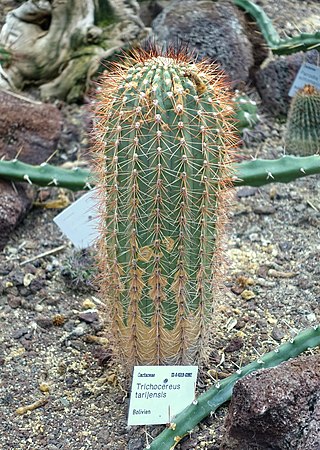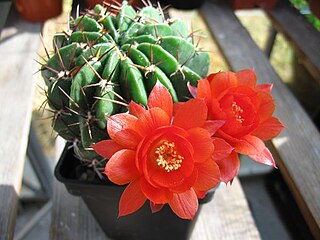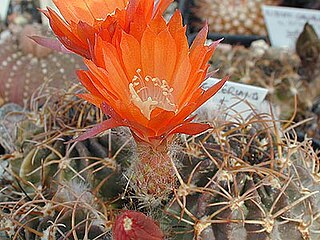
Cleistocactus winteri is a succulent of the family Cactaceae. Its common name is the golden rat tail. Cleistocactus winteri subsp. colademono, as its synonym Cleistocactus colademononis, has gained the Royal Horticultural Society's Award of Garden Merit.

Lobivia backebergii is a species of flowering plant in the cactus family Cactaceae, native to eastern Bolivia and southern Peru.

Lobivia cinnabarina is a species of cactus first described in 1885.

Lobivia ancistrophora is a species of cactus. It has a globular shape, few spines, with large, white flowers attached to long, green tubes. It occurs in Bolivia, at altitudes of 600–1800 metres. Under its synonym Echinopsis ancistrophora it has gained the Royal Horticultural Society's Award of Garden Merit.

Soehrensia formosa, is a species of Echinopsis found in South America. In north-western Argentina, Bolivia and northern Chile. First published in Cactac.: Handb. Kakteenk. 3: 1678 in 1959.

Echinopsis densispina, is a species of Echinopsis found in Argentina.

Echinopsis aurea, is a species of Echinopsis found in Argentina.

Lobivia ferox, is a species of Lobivia found in Bolivia and Argentina.

Lobivia obrepanda, is a species of Lobivia found in Bolivia.

Soehrensia huascha, is a species of Soehrensia in the Cactaceae family, found in north western Argentina. First published in Cactaceae Syst. Init. 29: 5 in 2013.

Lobivia pentlandii, is a species of Lobivia found in Bolivia and Peru.

Soehrensia tarijensis, is a species of Soehrensia, in the cactus family. It is native to Bolivia and northwestern Argentina.

Lobivia schieliana, is a species of Lobivia found in Bolivia and Peru.

Lobivia tiegeliana, is a species of Lobivia found in Argentina and Bolivia.

Lobivia maximiliana, is a species of Lobivia found in Bolivia and Peru.

Haageocereus pseudomelanostele is a species of Haageocereus found in Peru

Cleistocactus buchtienii is a species of columnar cacti in the genus Cleistocactus.

Echinopsis marsoneri is a species of cactus from Argentina and Bolivia.

Lobivia tegeleriana is a species of Lobivia found in Peru.
Lobivia pugionacantha, is a species of Lobivia found in Argentina and Bolivia.




















